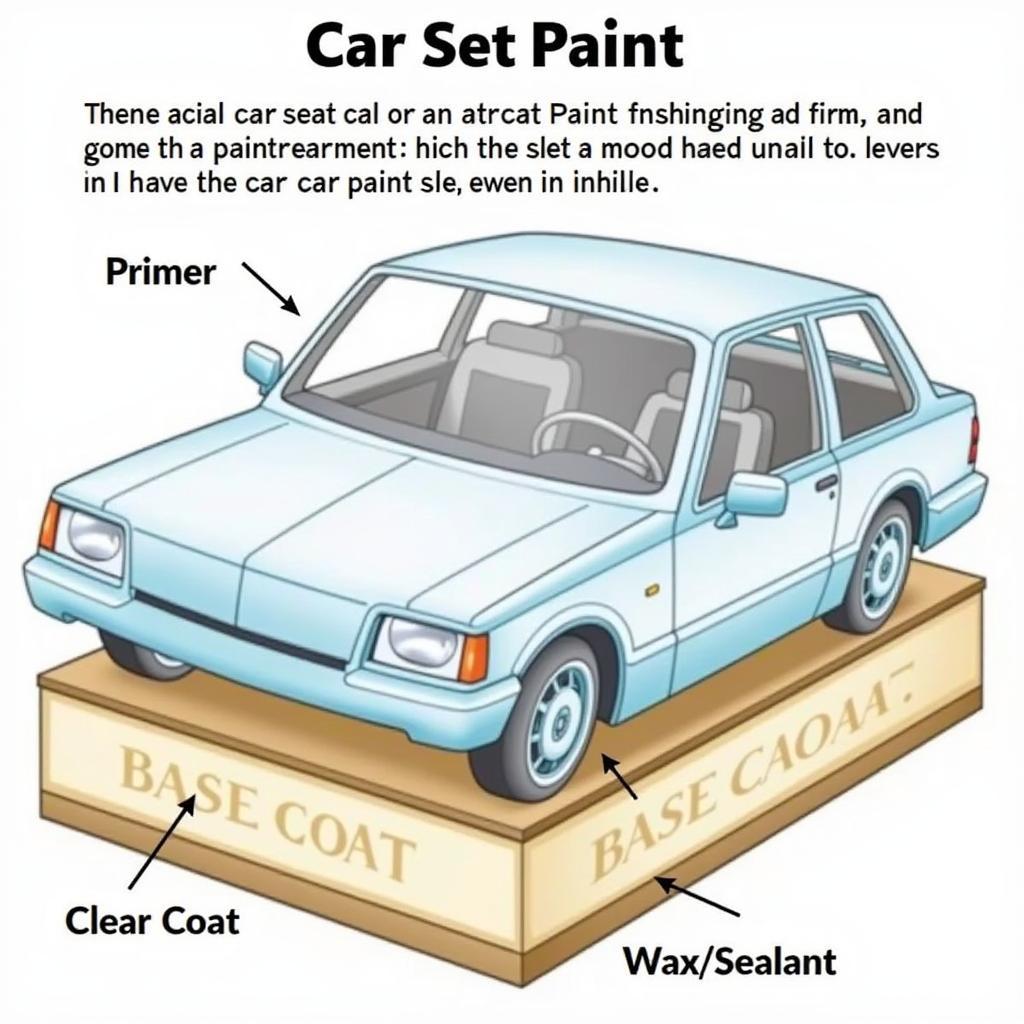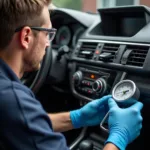Maintaining your car’s paint job is about more than just aesthetics; it’s crucial for protecting your investment. Scratches, chips, and fading can significantly impact your car’s resale value and even lead to rust and corrosion. Whether you’re dealing with minor scratches or more severe damage, this comprehensive guide will provide expert advice on how to repair car paint and restore its showroom shine.
Understanding the Layers of Car Paint
Before diving into repair techniques, it’s important to understand the composition of car paint. Typically, there are four layers:
- Primer: This base layer provides a smooth surface for the paint to adhere to and protects the metal body from corrosion.
- Base Coat: This layer provides the color and is usually composed of pigments mixed with a resin binder.
- Clear Coat: This transparent layer sits atop the base coat, providing protection from UV rays, scratches, and environmental contaminants.
- Wax/Sealant: These optional layers offer additional protection and enhance the paint’s shine.
 Car Paint Layers Diagram
Car Paint Layers Diagram
Common Car Paint Problems and Solutions
From minor imperfections to more serious issues, here’s a look at common car paint problems and effective DIY repair methods:
1. How to Repair Car Paint Scratches
- Light Scratches (Clear Coat Only): These can often be buffed out using a polishing compound and a microfiber cloth. Apply the compound in a circular motion, working your way outward from the center of the scratch.
- Deep Scratches (Through the Base Coat): For deeper scratches that expose the primer, you’ll need to use a touch-up paint pen or kit that matches your car’s paint code.
For more detailed information on fixing clear coat issues, refer to our guide on how to repair car paint clear coat failure.
2. How to Repair Car Paint Chips
- Small Chips: Clean the chip with rubbing alcohol, then apply touch-up paint in thin layers, allowing each layer to dry completely.
- Large Chips: Larger chips may require filling with automotive primer before applying touch-up paint. You can then sand the area smooth and blend it with the surrounding paint.
If you’re dealing with rock chips, you can find specific advice in our guide on how to repair car paint chips from rocks.
3. How to Repair Car Paint Oxidation
- Mild Oxidation: A good polish with a rubbing compound can often remove light oxidation and restore shine.
- Severe Oxidation: For heavy oxidation, you might need to use a more aggressive compound or even wet sand the affected area.
Learn more about tackling paint oxidation in our comprehensive guide: how to repair car paint oxidation.
4. Addressing Faded Car Paint
Exposure to sunlight and harsh weather conditions can cause car paint to fade. While a professional paint job is the most effective solution, you can temporarily restore some color and shine using a color-restoring compound.
5. Dealing with Car Paint Overspray
Overspray occurs when paint particles land on a surface they weren’t intended for. To remove overspray, you can use a clay bar or a dedicated overspray remover product. These products work by lifting the paint particles off the surface without damaging the underlying paint.
Professional vs. DIY Car Paint Repair
While DIY car paint repair can effectively address minor imperfections and save you money, some situations call for professional help. Consider these factors:
DIY:
- Cost-effective for minor scratches, chips, and light oxidation.
- Convenient for small touch-ups and quick fixes.
- Requires basic skills and easily accessible materials.
Professional:
- Essential for severe paint damage, dents, or rust.
- Ensures a high-quality finish that matches the original paint job.
- Requires specialized tools, expertise, and a controlled environment.
“For more extensive paint damage or if you’re unsure about tackling the repair yourself, it’s always best to consult a qualified auto body professional,” advises John Miller, a seasoned auto body technician with over 20 years of experience. “They have the skills and equipment to restore your car’s paint to its former glory.”
Preventing Future Car Paint Damage
Prevention is always better than cure. Here are some tips to protect your car’s paint and minimize the need for repairs:
- Regular Washing: Wash your car regularly using a pH-neutral car wash soap to remove dirt, grime, and contaminants that can damage the paint.
- Waxing and Sealing: Apply a coat of wax or sealant every few months to create a protective barrier against UV rays, scratches, and environmental pollutants.
- Covered Parking: Whenever possible, park your car in a garage or under a carport to shield it from the elements.
- Bird Droppings and Tree Sap: Clean off bird droppings and tree sap promptly as they can etch into the paint if left unattended.
- Careful Driving and Parking: Avoid driving too close to other vehicles or obstacles to prevent scratches and dings. Park away from areas prone to falling objects or where your car might get bumped.
Conclusion
Maintaining your car’s paint job is an ongoing process that requires attention and care. By understanding the causes of common car paint problems and following the repair techniques outlined in this guide, you can keep your car looking its best for years to come. Remember, early detection and prompt action are key to preventing minor issues from escalating into major expenses. For extensive damage or if you’re unsure about a repair, always seek the expertise of a qualified auto body professional.
FAQs about Car Paint Repair
- Can I use nail polish to repair car paint chips?
While tempting for a quick fix, nail polish is not recommended. It doesn’t adhere well to car paint, won’t match the color accurately, and can actually damage the surrounding paint. - How long does touch-up paint take to dry?
Drying time varies depending on the type of touch-up paint and environmental conditions. It’s best to refer to the product instructions for specific drying times. Generally, allow at least 24 hours for touch-up paint to cure completely before washing or waxing the area. - Can I wet sand my entire car to remove scratches?
Wet sanding is a technique best left to professionals. If not done correctly, it can damage the paint and lead to an uneven finish. - How often should I wax my car?
It’s generally recommended to wax your car every three to four months. However, factors like climate, driving conditions, and the type of wax used can influence this. - What is the best way to remove tree sap from my car’s paint?
Soak a cloth in rubbing alcohol or use a dedicated tree sap remover. Gently rub the affected area until the sap dissolves. Avoid using abrasive materials that can scratch the paint.
For more insights, explore our guides on:
- http www.wikihow.com repair-car-paint-chips
- [how to repair car paint bad match](https://carrepairon.com/how to repair car paint bad match/)
Need personalized assistance with your car repair needs? Contact our expert team 24/7 via WhatsApp: +1(641)206-8880, Email: [email protected]. We’re here to help you get back on the road with confidence.

